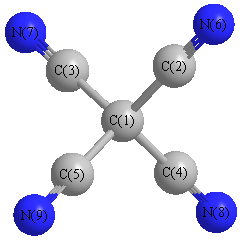Vibrational Frequencies calculated at QCISD(T)/TZVP
| Mode Number |
Symmetry |
Frequency
(cm-1) |
Scaled Frequency
(cm-1) |
IR Intensities
(km mol-1) |
Raman Act
(Å4/u) |
Dep P |
Dep U |
|---|
| 1 |
A1 |
2301 |
2216 |
|
|
|
|
| 2 |
E |
105 |
101 |
|
|
|
|
| 3 |
E |
105 |
101 |
|
|
|
|
| 3 |
T1 |
311 |
300 |
|
|
|
|
| 4 |
T1 |
311 |
299 |
|
|
|
|
| 4 |
T1 |
311 |
299 |
|
|
|
|
| 5 |
T2 |
2297 |
2212 |
|
|
|
|
| 5 |
T2 |
2297 |
2212 |
|
|
|
|
| 5 |
T2 |
2297 |
2212 |
|
|
|
|
| 6 |
T2 |
1082 |
1042 |
|
|
|
|
| 6 |
T2 |
1082 |
1042 |
|
|
|
|
| 6 |
T2 |
1082 |
1042 |
|
|
|
|
| 7 |
T2 |
583 |
561 |
|
|
|
|
| 7 |
T2 |
547 |
526 |
|
|
|
|
| 7 |
T2 |
547 |
526 |
|
|
|
|
| 8 |
T2 |
547 |
526 |
|
|
|
|
| 8 |
T2 |
546 |
526 |
|
|
|
|
| 8 |
T2 |
546 |
526 |
|
|
|
|
| 9 |
T2 |
140 |
135 |
|
|
|
|
| 9 |
T2 |
140 |
135 |
|
|
|
|
| 9 |
T2 |
139 |
134 |
|
|
|
|
Unscaled Zero Point Vibrational Energy (zpe) 8655.9 cm
-1
Scaled (by 0.9632) Zero Point Vibrational Energy (zpe) 8337.3 cm
-1
See section
III.C.1 List or set vibrational scaling factors
to change the scale factors used here.
See section
III.C.2
Calculate a vibrational scaling factor for a given set of molecules
to determine the least squares best scaling factor.
